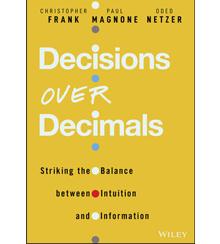In a data-led world, intuition still matters
A new book argues the best decision makers combine good data with their own good judgment.

Decisions Over Decimals: Striking the Balance between Intuition and Information
by Christopher Frank, Paul Magnone, and Oded Netzer (Wiley, 2022)
For as long as there have been decisions, people have used facts (lately known as data) to make them, along with reason and intuition. Nowadays, though, data often seems to be making decisions for us. Just as ‘analytics’ has changed the face of sports, business data prompts computers to order products, cut prices, or take other actions that once required human thought and intervention.
But data needs people just as much as people need data. Business leaders are still the ones who have to decide whether to launch a new product line, expand into a new continent, buy or sell a business, or change a venerable logo. So how can managers use the torrent of data available to them to make the best decisions? That is the timely subject of Decisions Over Decimals, a concise guide to decision-making in the age of analytics written by Christopher Frank, Paul Magnone, and Oded Netzer, a trio of business veterans associated with Columbia University (as well as American Express, Google, and Amazon, respectively).
“The challenge in today’s world is not the lack of information but the judgment to use it,” they write. Data-based decision-making is unavoidable, but it comes with risks: “Data and numbers tend to provide the comfortable feeling of accuracy and certainty, but they rarely tell us the full story. Numbers alone can never provide a perfect solution or answer, and they will never immunize decision-makers from faltering.”
What business leaders need, the authors argue, are techniques for combining good data with their own good judgment. Over the years, they’ve developed an approach that they call Quantitative Intuition (QI) to help executives make informed choices. And they are convinced that QI, oxymoronic as it may sound, can be learned. “Combining quantitative information with intuition—human judgment developed through experience and close observation—is indispensable.”
In its broadest outlines, QI doesn’t look terribly different from what any sensible person would do to make a decision. But as the authors walk us through their process chapter by chapter, a variety of useful insights, large and small, emerges.
For example, they cite the late organizational theorist Russell Ackoff’s observation that “we fail more often because we solve the wrong problem than because we get the wrong solution to the right problem.” Their point is that you don’t know what data you really need until you properly frame what it is you’re trying to decide. The data can only take you so far on this essential question because you are the one who has a view of the broader business landscape, including, of course, the complexity of your own business. “Don’t expect the data to provide both the questions and the answers,” the authors warn. “It is your responsibility to home in on the essential question and then combine data with intuition to attempt to identify the answers.”
Because the authors consider clarifying the problem to be so important, they believe it’s worth senior management investing time to do so up front, which will save time—and error—for everyone later. “Why?” questions, asked of subordinates in near childlike fashion, can help in problem-defining. Why do you want to conduct such a study? Oh, to know customers better. Great, but why do we want to know them better just now? And so forth, leading eventually to the real issue at stake.
Defining the problem first and then working backward toward the data can put you in some good company. The authors cite the example of Amazon. There, when people have an idea for a new product or service, they have to write up a press release and FAQs to help them and everyone else understand what it is, how it will work, and how various contingencies would be handled. That process helps all parties gain insight into what they really need to know to determine if the scheme is a good idea.
This sort of thing will help you focus on the right data. But you also need to make sure the data is right. Here, again, the authors have good advice: in both defining the problem and confronting the data, they emphasize the importance of asking powerful, probing questions. In particular, they recommend developing what they call “IWIK”—I Wish I Knew—questions designed to elicit data actually relevant to making a decision. All data, however obtained or elicited, must be rigorously interrogated. Is it accurate? Do means and medians mask explosive outliers? Is the period covered by the data the relevant one? Were the numbers you saw the result of posing the right questions? What biases might have influenced how data was harvested and presented?
In working with data, managers are exhorted to cultivate intuition by using back-of-the-envelope calculations, which will give a ready feel for magnitude and plausibility. Data must be accurate, but it needn’t be too precise. And all parties must learn to synthesize rather than merely parroting or summarizing. What matters is meaning.
Data must be accurate, but it needn’t be too precise. And all parties must learn to synthesize rather than merely parroting or summarizing. What matters is meaning.
In presentations, for example, make the bottom line the top line or, as we say in the news business, don’t bury the lede. The authors: “We should encourage our teams to not stop at the stage of what the analyses say and inspire them to also think about what this means for them or the organization.” In fact, people have to go further, from “so what?” to “now what?” In other words, go beyond “What does it mean?” to address “What are we going to do about it?”
Sooner or later—and better sooner—a decision has to be made. The authors are writing for corporate executives and advocate a fairly structured process, including, for instance, “Begin with agreement from stakeholders on the objective, timeline, and who must participate in a decision” and “Consider whether the decision is reversible or not, and if it is not reversible, can it become reversible?” But they also speak with the voice of experience to offer such good general advice as, “Focus on being vaguely right rather than precisely wrong. Get the best data you can, even if it is not perfect. With or without perfect data, a decision (and a good one) needs to be made.”
“Successful decision-makers,” they go on to tell us, “balance data, experience, and intuition. They quickly sort through information, apply judgment, and are fierce interrogators of data to cultivate sharp insights. They know there is more to decision-making than just the data. They resist being intoxicated by information.”
You should too.
Author profile:
- Daniel Akst is a business writer, author, and novelist based in New York’s Hudson Valley. His books include Temptation: Finding Self-Control in an Age of Excess.



